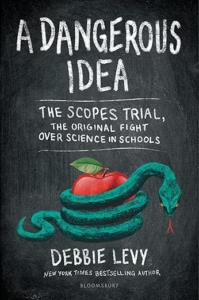A Dangerous Idea: The Scopes Trial, the Original Fight Over Science in Schools
Debbie Levy
Bloomsbury USA Children’s
Published January 14, 2025
Amazon | Bookshop | Goodreads
About A Dangerous Idea: The Scopes Trial, the Original Fight Over Science in Schools
One hundred years ago, a small-town science teacher ignited a nationwide debate over what students should learn in school–and who should decide.
- “Compelling.” –School Library Journal, starred review
- “Timely.” –Booklist, starred review
- “Insightful.” –Horn Book, starred review
A Junior Library Guild Gold Standard Selection
In 1925, when Tennessee lawmakers banned the teaching of evolution in public schools, teacher John Scopes challenged the law–and set off a gripping circus of a legal battle. Two masterminds faced off in a blistering courtroom debate over creationism and natural selection, each armed with the books they believed belonged in classrooms. Celebrity politician William Jennings Bryan relied on the Bible to make his case, while legal luminary Clarence Darrow defended Charles Darwin’s groundbreaking books On the Origin of Species and The Descent of Man. Their clash would go down in history as the Scopes Monkey Trial.
A century later, here is the riveting truth of what happened and why it matters. For a nation still arguing about the books and ideas that young people should encounter, award-winning author Debbie Levy delivers an important, insightful and expertly-researched account of our history that illuminates the challenges we face today.
- “Compelling.” –School Library Journal, starred review
- “Timely.” –Booklist, starred review
- “Insightful.” –Horn Book, starred review
My Review
I’m not sure there’s any way to read this book and not see parallels to some of the challenges we’re still facing culturally and in our education system today. Many of these parallels were probably in the author’s mind as she wrote this book. Between the wild increase in book bans and challenges to the culture war over faith and science, I couldn’t help seeing earlier versions of some of those conflicts in A Dangerous Idea.
The book begins with a biographical sketch of each of the major players in the trial. Readers are introduced to John Scopes, a teacher in a small Tennessee town. Then, they meet William Jennings Bryan and Clarence Darrow. Levy gives background information on Bryan and Darrow, so that when she shifts to describing the trial, readers can understand their behavior. They’re familiar with the personal beliefs of each man and the long-standing rivalry between them.
It’s kind of wild to think that this trial happened one hundred years ago this year. In some ways, our understanding of evolution has advanced. I can’t remember the last time I heard someone incorrectly gripe that it meant humans descended from monkeys. On the other hand, last year, a popular conservative commentator called science a cult. So, obviously, there’s still a lot of tension out there.
Readers looking to understand the Scopes Trial will find a comprehensive explanation in A Dangerous Idea. It may help add context to some current conflicts as science confirms and explores new ideas, and some resist updating their ideas.
Content Notes
Recommended for Ages 12 up.
Profanity/Crude Language Content
Mild profanity used a few times in quotations from historical figures.
Romance/Sexual Content
References to marriages of historical figures.
Spiritual Content
References to William Jennings Bryan’s personal spiritual beliefs throughout his life. References to the beliefs of other people at the time concerning whether the Bible should be interpreted literally. The text also explores cultural thoughts and beliefs about whether and when faith and science intersect.
Violent Content
References to the fact that many people rejected Darwin’s research on evolution because it didn’t support their racist ideas. References to white supremacy. The author also quotes from a commonly used science textbook of the time, which states that the poor and unwell should not be allowed to have children. Levy points out that though the textbook received a lot of criticism for its reference to evolution, these ugly, wrong ideas were not mentioned as problematic.
Drug Content
References to the 18th Amendment, which prohibited the sale of alcohol.
Note: This post contains affiliate links, which do not cost you anything to use but help support this blog. I received a free copy of this book in exchange for my honest review. All opinions are my own.
